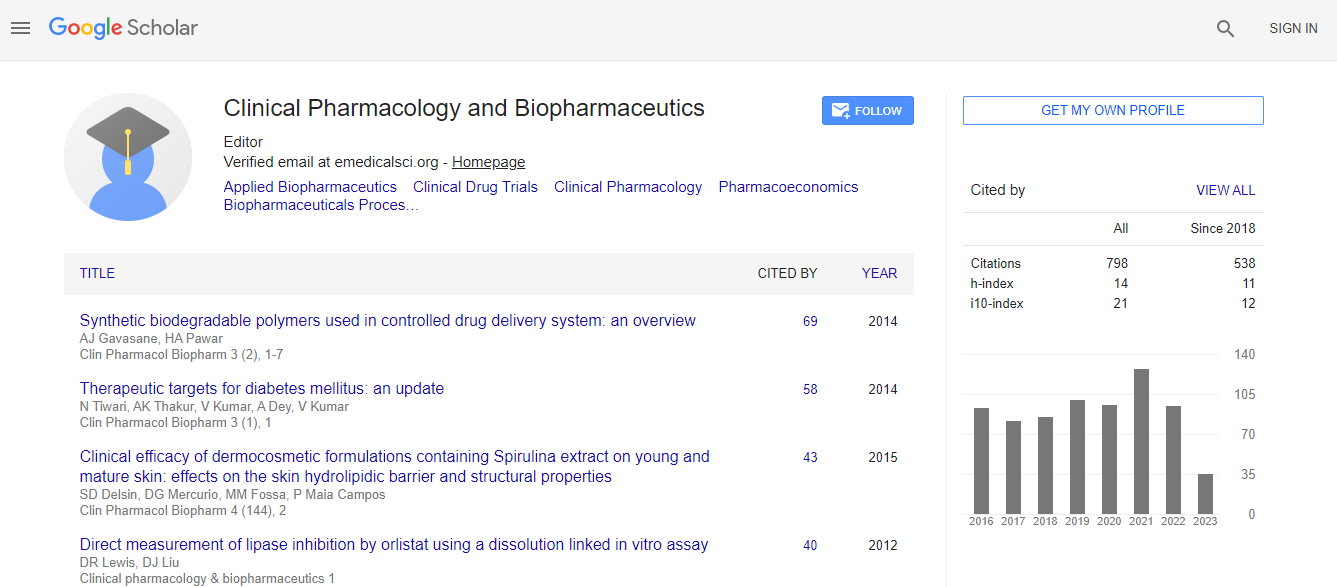Our Group organises 3000+ Global Conferenceseries Events every year across USA, Europe & Asia with support from 1000 more scientific Societies and Publishes 700+ Open Access Journals which contains over 50000 eminent personalities, reputed scientists as editorial board members.
Open Access Journals gaining more Readers and Citations
700 Journals and 15,000,000 Readers Each Journal is getting 25,000+ Readers
Google Scholar citation report
Citations : 1089
Clinical Pharmacology & Biopharmaceutics received 1089 citations as per Google Scholar report
Clinical Pharmacology & Biopharmaceutics peer review process verified at publons
Indexed In
- CAS Source Index (CASSI)
- Index Copernicus
- Google Scholar
- Sherpa Romeo
- Genamics JournalSeek
- RefSeek
- Hamdard University
- EBSCO A-Z
- OCLC- WorldCat
- Publons
- Euro Pub
- ICMJE
Useful Links
Recommended Journals
Related Subjects
Share This Page
Post Conditioning Ozone Ameliorates Ischemia Reperfusion Injury And Flap Viability In Rats
International Conference and Expo on Biopharmaceutics
Cagdas Elsurer, Merih Onal, Nebil Selimoglu, Mustafa Yilmaz, Ender Erdogan, Jale Bengi Celik and Ozkan Onal
Selcuk University Medical Faculty Department of Otolaryngology, Turkey Meram Educational and Training Hospital Department of Otolaryngology, Turkey Meram Educational and Training Hospital Department of Plastic Surgery, Turkey Selcuk University Med
Posters-Accepted Abstracts: Clin Pharmacol Biopharm
Abstract
Introduction: Muscle flap transfer is a routine method used in reconstructive procedures but flap morbidity is a serious problem. It is believed that ischaemia/ reperfusion injury (IRI) plays a major role in the survival rate of flaps following grafting. Agents which have an antioxidant, anticoagulant, anti-inflammatory and anti-apoptotic activity are beginning to be investigated for treatment, to protect from ischaemia/reperfusion damage. Pretreatment with various agents and preconditioning strategies on clinical outcomes are considered in many studies. Ozone oxidative postconditioning is a novel treatment to protect organs from IRI. The aim of this study was to evaluate the possible beneficial effects of ozone on flap survival in a rat muscle flap model. Material and Method: After the approval of Selcuk University animal ethics committee, 28 adult Wistar rats were used for the study. Transverse incision was applied in the half of the chest to expose the pectoralis muscle. Pectoral muscle flap was removed in accordance with the surgical technique and was sutured back in place in sham-operated control group (C) (n:7). SF was administered intraperitoneally during the seven days without creating ischemia reperfusion injury and at eighth day the rats were sacrified. Ischemia Reperfusion (IR) group (I/R) (n:7) were subjected to flap ischemia by axillary artery was ligatured with 6.0 vicryl for 3 hours. After 3 hours, the suture was released for reperfusion and 24 hours of reperfusion was allowed. 1 mg / kg ozone was administered intraperitoneally for seven days after surgery in sham operated+ozone(O) group (n:7) without creating ischemia reperfusion injury and at eighth day the rats were sacrified. In ozone+IR group (n:7), the ischemia reperfusion injury was created (as in group 2) and 1 mg/kg ozone was administered intraperitoneally for seven days after the ischemia/reperfusion procedure and at eight day rats were sacrified. Intracardiac blood was taken under anesthesia for sacrification. Pectoralis flap muscles were removed for histopathological and biochemical examination. The flap survivals were evaluated according to the apoptosis rates of muscle cells with TUNEL (terminal deoxynucleotidyl transferase dUTP nick end labeling) assay. Flap tissue samples were evaluated for superoxide dismutase (SOD), glutation peroxidase (GSH-Px), malondyaldehide (MDA) and blood samples were surveyed for total oxidant score (TOS) and total antioxidant capacity (TAC) analysis. The differences in pathological findings between the study groups were analyzed using the Kruskal├ó┬?┬?Wallis test and comparisons were performed using the Mann├ó┬?┬?Whitney U test. Results: For histomorphometric evaluation, muscle cell organization, vascularity, fibrotic and degenerative changes and mononuclear cell infiltration degrees were surveyed. To evaluating apoptosis of the pectoral muscle at the cellular level, TUNEL was performed. Apoptotic Index was calculated to make comparision between groups (Apoptotic Index (AI)=Total apoptotic cell count /100). Ozone group without IR injury, apoptotic index score was the lowest compared to the other groups (p<0.05). In Ozone + IR group, apoptotic index was found to be lower than IR group (p<0.05). In sham operated control group, apoptotic index was found to be lower and statistically significantly compared to the IR and IR+Ozone groups (p<0.05). The difference according to the antioxidant parameters SOD, GPX and TAC values were found to be highest in ozone group (p<0.05) and lowest in IR group. The difference according to the oxidant parameters MDA and TOS were found to be highest in IR group and decreased in ozone group (p<0.05) . Discussion: Ischemia reperfusion injury is implicated as the cause of flap losses. Many experiments have shown beneficial effects of ozone on ischemia-reperfusion injury in different organs and tissues. The present study demonstrates that ozone administration attenuates the muscle flap injury caused by IR. This benefit correlates with elevated cell proliferation and decreased cell death via apoptosis. Further clinical trials may be necessary to determine whether ozone/oxygen mixture may be beneficial as an agent to maintain flap viability in muscle flaps.Biography
Email: drozkanonal@selcuk.edu.tr

 Spanish
Spanish  Chinese
Chinese  Russian
Russian  German
German  French
French  Japanese
Japanese  Portuguese
Portuguese  Hindi
Hindi 
